So typically there is only aircraft noise 25% of the time, and when there is
aircraft noise it
is not intrusive. Guests sometimes mention animal noise, they rarely
mention aircraft noise.
This map comes from www.prg.aero/en/prague-airport/environment/noise-monitoring/approach-to-solving-the-noise-issue/
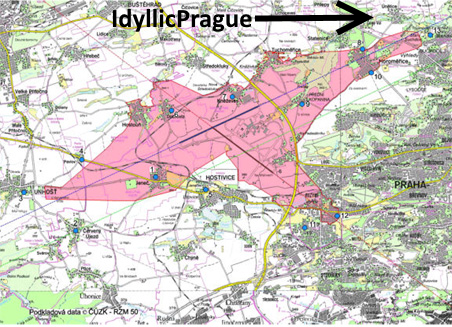
++++++++++++++++++++++++++++++++++++++++++++++++++++++++++++++
Click
here for details of horse riding and horse drawn carriages direct from your
Cottage.
See
www.expats.cz/prague/article/czech-cooking/picnicking-and-barbecuing-in-prague/
Rambling and Exploring by bicycle
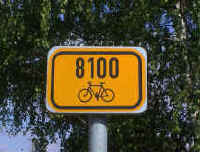 Conifer
Cottage is not on a road, but is on "cycle track 8100".
Conifer
Cottage is not on a road, but is on "cycle track 8100".
(But do not worry, cars and
taxis can drive up to the house!)
By request, we will be
pleased to provide you with bicycles.
Following a stream flowing down into the Vltava river, cycle
track 8100 runs
through a delightful forested National Park
called "Tyche Udoli" which
means "Silent Valley". Inclines are
gentle and the track has a
reasonable surface, making cycling
and rambling
easy and pleasurable. Click
here for photos.
On reaching the main Vltava river, cycle tracks continue along both banks of
the river.
Particularly to be recommended is the chain ferry, which for
15kc will carry you and your
bicycle across the river to explore further cycle
tracks on the far river bank.
Exploring on foot
The cycle tracks, paths, forests and lakes of the National Park are as
popular with
ramblers as with cyclists. The tranquil valley and
enticing paths lead to intriguing
wild life discoveries. Click here for photos
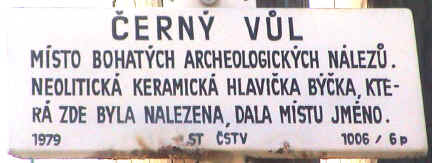
Cerny Vul translates as "Black
Bullock". A sign on the cycle
path
states "Cerny Vul is a site of rich
archaeological finds. A
Neolithic
ceramic bull's head found here gave
the village its name."
Únětice culture is the name given
to an early
Bronze Age
culture.
 Walking from the Cottage. The Cottage is on "Cycle Route
Walking from the Cottage. The Cottage is on "Cycle Route
8100" which is
clearly
marked. It is also marked as the
"blue route" with
white/blue/white trail
markers.
As you
leave the Cottage you can turn left or right. On foot, we
generally turn
left.
If you turn right you will eventually reach
Okor castle
- (click here) for
www.zamky-hrady.cz/6/okor.htm.
Turning left will follow the stream down
through
"Tiche Udoly"
(silent valley national park) to the main river.
One small
complication
- as you leave the Cottage and turn left onto Cycle Track 8100,
you will walk
past
two lakes on your right. Then suddenly the cycle track is signposted
up a very
steep
track to the left. You can follow that if you like - but we generally
walk
straight on
into "Unetice Village" and
Unetice Village Shop. If you keep heading
in
the same
direction with the stream on your right, you will rejoin "Cycle Track 8100"
soon
enough.
When eventually the stream you have been following
meets the main river, turn
left and follow the main river downstream. (Cycle Track 8100 takes a detour
around
the streets, but we recommend that you stay with the path by the stream,
it is a more pleasant walk.) After about
a mile, you will reach the "rope ferry"
across the main river. It is great fun
to cross
the river on the "rope ferry" - and
Cycle Track 8100 continues for miles the
other
side. Alternatively, having crossed
the river you can turn right
and continue up
river until eventually you will arrive
at Prague Zoo. That is a long cycle ride,
so
it would be
an extremely long walk!
 Another alternative is not to cross the river, but to carry
Another alternative is not to cross the river, but to carry
on on the same
side of
the main river, following the
river down stream. After about a mile the railway
is
on
your left, and a steep hill rises on your left. At the top
of that hill is an extremely
ancient Church, still in use,
claimed to be "the first Church in Bohemia" and situated
in the fascinating village of "Levý Hradec". Click
on the following
links for more pictures and information
1,
2,
3,
4,
5,
6.
Do have a look at the IdyllicPrague photos to get some
idea of where
you can walk. We love it!
For more details of "Tiché údolí" Silent Valley National Park click
here
Exploring by Bicycle
For a blog written by an enthusiastic local cyclist, click
here.
http://www.praguebikeblog.blogspot.com/
Exploring by Car
Maybe 10 minutes drive from the cottage is the ruin of
Okor castle, set in a delightful village
www.zamky-hrady.cz/6/okor.htm
For more details of the Prague 6 area
www.praha6.cz/eng/
"Silver Mountain" was once the source of European silver currency
and is the origin of the word "dollar"
www.kutnahora.cz/index.php?lns=2
http://whc.unesco.org/en/list/732/
A chapel built of human bones can be found at
www.ludd.luth.se/users/silver_p/kutna-1.html
Cesky Raj (Czech Paradise) is a delightful area to explore,
maybe only 1 hour from the cottage
www.ceskyraj.cz/english/start.htm
Prague is fantastic for theatre, opera, concerts etc
www.opera-rkm.cz/operagala/
There are many fascinating castles in Czech Republic
www.zamky-hrady.cz/2/hrady.htm
Karlstejn is the most famous castle near to Prague.
www.zamky-hrady.cz/2/karlstejn.htm
There are several spa towns in Czech Republic
www.karlovyvary.cz/static/soucasnost_5_2.asp?LangId=2&Kol=2
Cesky Krumlov is a favourite historic Czech town
http://new.ckrumlov.cz/php/webcam/index.php?lang=en
Telc gives a wonderful feeling of history and calm
www.telc-etc.cz/telc/?target=webcam
The Krkonose mountains form a natural northern border with Poland
www.ergis.cz/krkonose/index.php?lang=en&menu=2&search_filter=2&typ=menu
Other Ideas From Suchdol University
There are plenty of useful ideas here
http://www.czu.cz/en/?r=957&i=1675
There is a University Campus near IdyllicPrague in Suchdol.
From Cerny Vul walk through the forest past 2 lakes to Únětice (click
here)
Walk past the Únětice shop. After the 3rd lake on your right, turn
diagonally
right up the hill through forest. At the top is Suchdol
Here are some suggestions from the University website: -
Museums
Náprstek Museum of Asia, Africa and America -
www.nm.cz
Art Galleries
National Gallery in Prague (Collection of old art) –
www.ng-ssu.cz
Centre for modern and contemporary art of the National
Gallery -
www.ngprague.cz
Theatres and Operas
Cinema Programmes
Music Clubs
Agharta Jazz Club – Krakovská 5, Prague 1
Rock Café – Národní 20, Prague 1
Malostranská Beseda – Malostranské Náměstí 21, Prague 1
Restaurants and Pubs in your vicinity (Prague 6)
Restaurace – Pub na Farmě (CZU refectory, ground floor)
Mon-Fri 10:30 - 23:00
Starosuchdolská Pub (Starý Suchdol) 11:00 – 23:00
Grill Billiard Club, Kafkova 47, Prague 6; Mon-Thu 9:00
– 02:00, Fri 9:00-03:00, Sat-Sun 15:00-02:00
U Zívalů Pub, Kyjevská 1, Mon-Fri 10:00-23:00, Sat-Sun
11:30-22:30
Budvarka Pub, Wuchterlova 22, Mon-Sun 13:00-23:00
Pizzeria Francesco, Kyjevská 12
Pizzeria Grosetto Pepini, Jugoslávských Partizánů 8
Pizzeria Sklípek, Starý Suchdol.
Vegetarian Restaurants in Prague
Govinda´s, Soukenická 27 Prague 1, Mon-Fri 11:00 – 18:00
Govinda´s , Na Hrázi 4, Prague 8, Mon-Fri 12:00 – 18:00
Balarama, Orlická 9, Prague 3, Mon-Fri 11:00 – 17:30
Country Life, Melantrichova, Mon-Thu 11:00 – 18:00
Albio, Truhlářská, Mon-Sun 12:00 – 22:00
International Bookstores
Oukydouky, U Veletržního Paláce, Prague 7
Bohemian Ventures, Nám. Jana Palacha 2, Prague 1
U Knihomola, Mánesova 79, Prague 2
Big Ben Book Store, Malá Stuparská 5, Prague 1 phone:
224 826 565
 | Finance |
Currency: Koruna (plural koruny) or crown,
abbreviated Kč (CZK in banks).
Each crown is divided into 100 haléř or hellers.
Bank notes (50, 100, 200, 500, 1000, 2000, 5000 CZK)
bear a forgery- resistant silver strip
and several watermarks. Coins in use are 0.50, 1, 2, 5,
10, 20 and 50 CZK.
The Czech crown is fully convertible. The approximate
rate of CZK towards the EUR is 28: 1.
Exchange: Never change currency on the street.
The official exchange rates of the
Czech National Bank can be consulted at
www.cnb.cz/en.
Current conversion rates
at
www.kb.cz/en.
It´s best to visit one of the main banks (Česká
Spořitelna, Komerční Banka,
Česká Obchodní Banka) or its subsidiary office (Vítězné
náměstí and Dejvická street inPrague 6)
open usually 8:00 – 17:00 Mon-Fri. You may also see
American Express (Václavské náměstí 56,
Phone 222 800 237) and Thomas Cook´s (Národní 28, Phone
221 105 371).
ATMs (Bankomat): There are plenty of ATMs (Bankomat)
in Prague, practically at every corner.
There is even an ATM at the ground floor of Menza
(Refectory) CULS, and at the local Suchdol bus stop
“Zemědělská Universita”. ATMs deliver local currency
only. You may use any of the following cards:
Master,Cirrus, Maestro, Eurocard, Visa and Visa Plus.
Basic commodity prices: A meal at the cheapest
pub will cost you around CZK 80. - , drinks not
included.
At a restaurant you pay CZK 150.- to 350.- for a
complete menu. Drinks cost between CZK 25.- and 75.-.
Clothes cost more or less the same as in other EU
countries. The price of a ticket to the cinema is
CZK 120. - to 150.- , to a concert between CZK 350.-
and 1800.-, to the opera between CZK 300.- and 1500.-.
Food in shops and supermarkets is cheaper than in the EU
(about 50%).
 | Travel |
Public transportation: The public transport
system in Prague is very cheap, reliable and
comprehensive.
For information on schedules and rates please consult
www.mhd-praha.cz
. You can buy tickets for CZK 20. -
at automatic dispensers, at stationery shops, newspaper
stands, etc. You must validate them right upon
entering the means of transport. They are valid for 60
min. There are also monthly, quarterly and year passes
available.
Taxis: Be careful if you´re getting a taxi in
Prague. Taxi drivers here have a reputation of being
notoriously dishonest.
Avoid hailing a taxi or taking a taxi from a taxi stand.
On the other hand, the dial-a-taxi companies tend to be
honest and reliable. Here are some of them: AAA Radio
Taxi: 222 333 222; City Taxi: 233 103 310; Halo Taxi:
244 114 411.
Bike: There´s plenty of bicycle paths in the
countryside around the CULS campus. But travelling by
bicycle to or
from the city centre is not at all recommendable. Prague
City Centre is not a bicycle-friendly place.
Travelling outside Prague: When you travel
outside Prague you may use your own car (don´t use your
car in the city,
it´s not worth it) or the train, Buses, or you may fly.
Train: Consult schedules and destinations at
www.cd.cz . For
international information phone: 840 112 113.
Eurail Passes for students are popular with US students
who want to visit other places in Europe as well.
These passes must be bought in your country of origin.
The Main Station is called Hlavní nádraží and you
may reach it with the Metro C (see public transport).
Bus: Consult schedules and destinations at
www.florenc.cz
or
www.studentagency.cz.
The Central Bus Station is called Praha- Florenc and you
may reach it either by Metro B or C (see public
transport).
Airport: The Prague International Airport is
close to the CULS campus (click on After your Arrival).
There is a 24 Hours Info line at the airport.
Phone:220 113 314. Also consult
www.csl.cz for
Airlines
operating from and to Prague.
 | Communication |
Post offices: The Main Post Office
Jindřišská 14, Prague 1 (Open O2:00 – 24:00), Post
Office Dejvice Kafkova 19 Praha 6
(Open weekdays 8:00 – 20:00, Saturday 8:00 – 13:00) Post
Office Suchdol Internacionální (10 minutes from the
campus,
Open Weekdays 8:00 – 18:00)
Inland calls: Public phones usually require
telephone cards. They cost CZK 200.- and you can buy
them at the
Post Office or at most News Stands (Trafika)
International calls: To make an international
call from the Czech Republic you may also use a
telephone card.
To phone home you may consult long distant carriers such
as AT and T (00420 00101), BTDirect (00420 04401).
Prices to countries in the EU and US are very
reasonable. Calling elsewhere may be costly.
Mobile Phones: Consult your mobile phone operator
at home on the conditions and prices in the Czech
Republic
(T Mobile, Eurotel, Vodafone)
Telephone Info: Domestic: 1180; International:
1181.
Express parcel shipping: DHL International
www.dhl.cz
See
http://www.prazskestezky.cz/unet/index.html
See
http://envis.praha-mesto.cz/rocenky/chruzemi/cr2_antx/chu63.htm
The
valley of the Únětický potok brook and adjacent slopes and plateaux in the
respective cadastres. Cadasters: Roztoky nr. Prague (district Prague-West),
Suchdol and Prague 6. Area: 114.2343 ha. Elevation: 195 - 300 m above sea level.
Established by the Ordinance of the Ministry of Education No. IX-357-2-51 of
August 10, 1951, the Ordinance of the Ministry of Education No. 100.988/51 of
September 9, 1951, and the Ordinance of the Ministry of Culture of the Czech
Republic No. 14 200/88 of November 29, 1988.
Protection
of the general character of the landscape, indigenous flora, minor fauna and
geological formations.
The
bedrock consists of Proterozoic rocks with the prevalence of greywackes,
siltstones and shales and a powerful strip of lydites (silicites in the west.
There are also veins of porphyric and basalt rocks. Loamy and stony screes,
deluvium, loess with rankers and brown earths on top, relics of
tropic weathering. Dispersed boulders below lyditeridges.
Large
woods with alternating cow-wheat oak and hornbeam, woodrush oak, heather oak and
hornbeam and maple woods. The formerly mown valley meadows change spontaneously
into alder woods. The northern bare slopes used to be covered with large heaths
which receded after forestation. Similarly the acidophilous rocky steppes
and sandy areas on southern slopes are becoming overgrown with shrubs -
hawthorn, dog rose, blackthorn and in succession sequence with ash and
oak trees. The number of important species includes Corydalis pumila in
oak and hornbeam wood, Alyssum montanum on the prophyrite vein,
Biscutella varia on the diabase vein, and Corynephorus canescens and
Helichrysum arenarium on sandy terraces.
The
wood is partly natural and continuous (testified to by the presence of
Acalles comutatus), partly artificial, including alien wood species (false
acacia, red oak, and others). This is reflected also in invertebrate fauna:
typical and significant species can be found in natural parts of the forest
only. The number of ground beetles includes e.g. Amara nitida, Poecilus
virens, Pterostichus burmeisteri and Abax ovalis, the number of
phytophagous leaf beetles e.g. Clytra quadripunctata, Cryptocephalus
marginatus, Phylotreta ochripes and Aphtona cyanella, the snout
beetles the terricolous Brachysomus echinatus, Trachodes hispidus. The
oaks host Polydrusus marginatus and Curculio pellitus, the hazel
Curculio nucum, the elm Magdalis armigera, the scots pine
Polydrusus impar and others. Plectophloeus erichsoni erichsoni from
the Pselaphidae family was found here. The butterfly species include e.g.
the swallow-tail (Papilio machaon) and the scarce swallowtail (Iphiclides
podalirius), the small tortoiseshell (Aglais urticae) and the garden
tiger (Arctia caja). The gastropods are represented by Perforatella
bidentata. Numerous vertebrate specis, especially birds. Nesting site of the
green and the grey woodpeckers and the wryneck. There are about 50 species of
passerines including the icterine warbler, the serin, the bullfinch, the
goldfinch and the yellow-hammer. Some 20 mammal species. However, the suslik and
the hamster have disappeared.
The
better part of the area (over 100 ha) is covered with mixed woods at present
with the prevalence of oaks (42.5%), pines (21.4%), hornbeams (10.9%) and
birches (7.7%). The admixture of the red oak propagates intensively by shoots.
Inadequate wood species planted after the Second World War devastated completely
some valuable areas, such as the area covered with Filipendula ulmaria
below the Kozí hřbety ridge.
The
forest was influenced anthropically as early as in the prehistorc time.
There is a Hallstatt mound burial ground on the plateau. The slopes were used as
pastures and subjected to secondary forestation only at the beginning of the
20th century. The area is threatened by heavy tourist traffic (from the nearby
city). Forest management conforms with the approved forest management plan.
Accidental tree felling, hunting, grazing. There is an educational track through
the reserve.
Kubíková
(1985), Kubíková, Molíková (1980).
[ Home
] [
Cottages
] [
Photos
] [
Guest Comments ] [
Travel ] [
City Tips ] [
Exploring the Countryside ]
[ Local Pubs
] [
Wheelchairs
] [Weddings]
[
Currency Converter
] [ Book Now!
] [
Contact Us
]

 Conifer
Cottage is not on a road, but is on "cycle track 8100".
Conifer
Cottage is not on a road, but is on "cycle track 8100".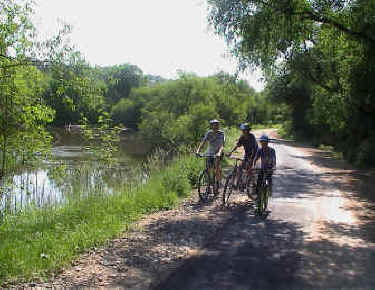
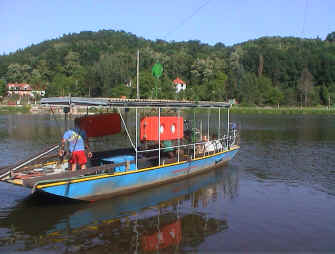
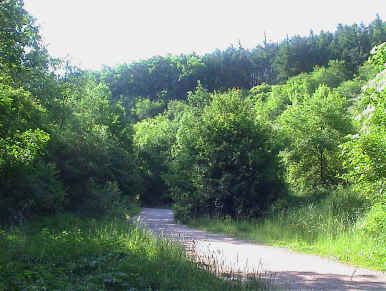
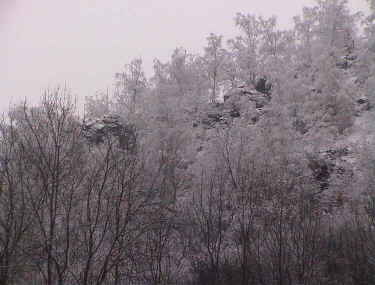
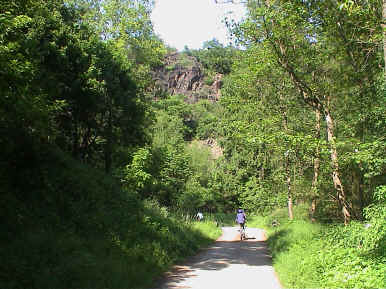
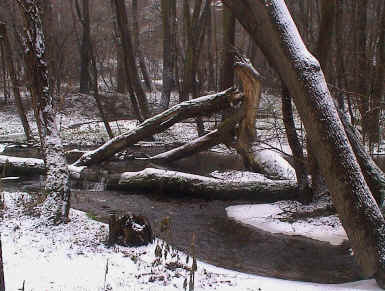

 Another alternative is not to cross the river, but to carry
Another alternative is not to cross the river, but to carry